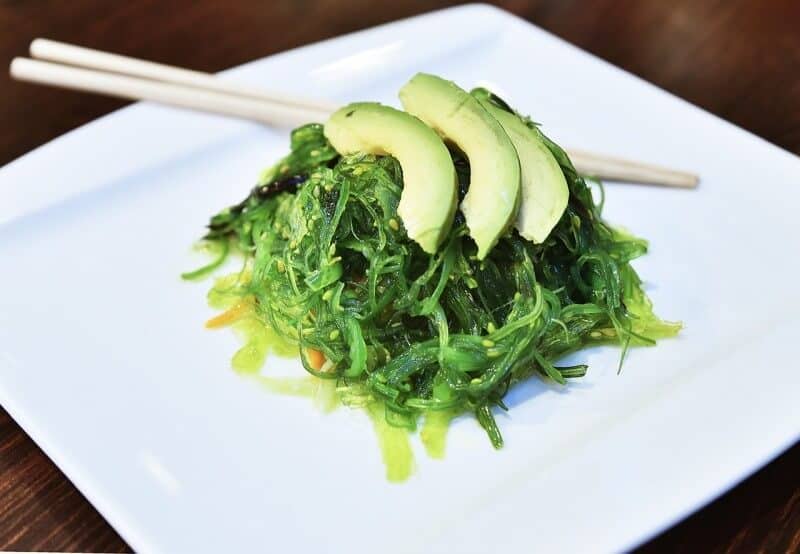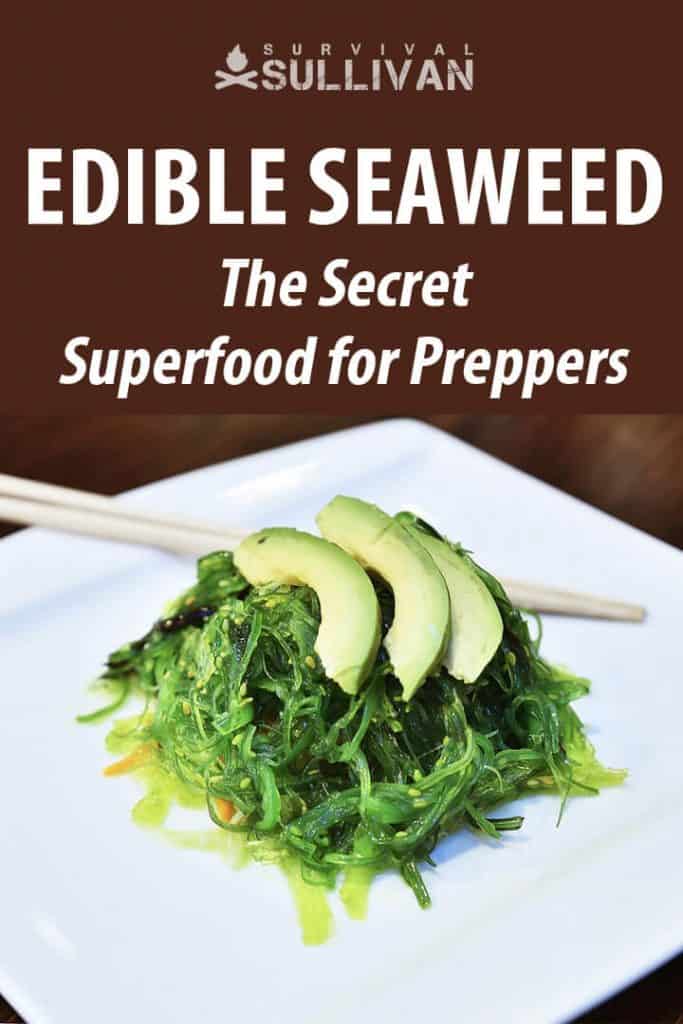If you’ve been looking into more natural foods, you already know that nature provides a wealth of things needed by the human body. It’s up to us to know where to find it and how to harvest it to make those edible foods work for us.
Edible seaweed, also known as sea vegetables, is something that has garnered increased attention in recent years. So like other naturally occurring edible foods, we thought we’d give you the rundown on edible seaweed and how you can use it to supplement your food supply both now and in a SHTF situation.

Types of Edible Seaweed
All edible marine seaweed belongs to one of three groups of multicellular algae: green algae, brown algae and red algae. We’ve listed some of the more commonly eaten ones below.
Disclosure: This post has links to 3rd party websites, so I may get a commission if you buy through those links. Survival Sullivan is a participant in the Amazon Services LLC Associates Program. As an Amazon Associate, I earn from qualifying purchases. See my full disclosure for more.
Agar-Agar
Also known as“kanten” or China grass, agar-agar is a red seaweed that is low in calories. It’s sold in powder or flakes and is most commonly used to thicken foods. Look for it in Indian food stores or online.
Vegans will find it’s the perfect alternative to gelatin. It will set up at room temperature and won’t “melt” in warm weather. Shelf life of Agar powder is eight months but it doesn’t “go bad”, just loses flavor and quality.
Aonori
Look for aonori in calm, shallow waters. It’s a Green laver, either enteromorpha spp or monostroma spp. You can find the latter in the gulfs and bays of Southern Japan. Aonori has up to 20% protein content which makes it a great survival food.
The Republic of Korea has had some limited success with cultivating it. There is a high demand for it in that region. Find it online or in stores in powder or flake form. It has a recommended shelf life of up to 12 months.
Arame
A brown seaweed with a mild sweet flavor, Arame is actually almost black in color. Its characteristic long, fine, wiry strands triple in size when soaked in water.
It’s high in fiber and contains iodine but has a milder flavor than its cousin hiziki. It’s one of the more versatile seaweeds and a good choice for preppers. Dried Arame has an indefinite shelf life if stored away from moisture and humidity.
Bladderwrack
If you’ve been to the Western coast of the United States, you may have come across foragers looking for Bladderwrack among the rocks. It’s a large leaf variety with a strong flavor of “seaweed”.
It’s high in iodine and tastes best when steamed. Before using freshly harvested Bladderwrack, be sure to rinse with warm water and soak to remove sand grains. Powdered Bladderwrack has a shelf life of 18 months to 2 years when stored in an airtight container free of moisture.
Dulse
Dulse is found around Grand Manan Island and the Bay of Fundy. It’s also common in Scotland and Ireland. Called “sea parsley” in Canada, Dulse is a flat red seaweed, that resembles red film tape. Look for it in the eulittoral and upper sublittoral zones and harvest by picking it from the rocks at low tide.
Dulse has a rich, meaty flavor and gelatinous texture which makes it a great salty, chewy snack. It is also great mixed into fried potatoes or added to soups or stews that need a long time to simmer. Dulse has been said to aid in removing heavy metal toxicity from the body and to support healthy brain function.
It’s high in protein, fiber, iron, and calcium. It aids the digestive process and can help metabolism and weight loss. Soak in hot water before adding to salads. Dried Dulse flakes need no refrigeration and have an indefinite shelf life according to Eden Foods and one user who stated her flakes were still good ten years later!
Hijiki
Considered a brown seaweed, hijiki is nearly black in color. It has a strong, salty flavor and is high in iron and fiber. Pair Hijiki seaweed with sweet vegetables, like carrots, to enhance flavor. It has been said to provide a boost of energy, aid the digestive system, improve metabolic efficiency, and strengthen bones.
Soak for 30 minutes before using. The minimum shelf life of powdered Hijiki is up to 12 months stored properly. Dried seaweed has an indefinite shelf life when stored correctly, but may lose flavor or quality over time.
Irish Moss
Also known as Chondrus crispus or carrageenan moss, Irish Moss has a long history of use in parts of Europe and Ireland. It’s primarily used for its thickening properties when boiled in water.
It can also be added fresh to seaweed salads or used as a garnish. Irish Moss gel or paste when refrigerated has a shelf life of up to 3 weeks. Dried Irish Moss has an indefinite shelf life.
Kelp
One of the largest of the seaweeds, you can find Kelp along the North Atlantic coast as well as around the world. It has a meaty flavor which makes it a great addition to soup stock.
You can also steam it and serve as a side dish. It’s high in iodine and can aid in thyroid gland regulation but can also cause issues with nutrient absorption if consumed too frequently. Kelp noodles are popular and have a shelf life of up to six months. Dried Kelp has an indefinite shelf life.
Kombu
Also called Haidai, Kombu is a brown seaweed that has become fairly popular due to its use in Asian cuisine. When you buy dried Kombu, its actually a mix of several species of Laminaria. Primarily found on Hokkaido’s Northern Island, Kombu grows on reefs and rocks in sublittoral zones.
It prefers calm water with temperatures between 3 and 20 degrees celsius. Small amounts can be found on Honshu’s northern shores. Dried kombu is required to have a printed expiration date but it can last indefinitely when stored in an airtight container, away from sunlight and warm temps. In fact, Kombu is known to have a better taste as it ages.
Nori
One of the most popular seaweeds, likely due to its use in wrapping sushi, Nori is also known as purple laver. It’s purple black in color and rich in beta-carotene with a protein content of 30-50%. It’s also high in vitamins C & A, folic acid, and niacin. Found in temperate intertidal areas worldwide, Nori has a pleasant flavor and works great for adding flavor to rice or pasta dishes.
It is cultivated in Japan, China, and the Republic of Korea. Attempts at cultivation on the U.S. coasts was thwarted by West coast residents and on the East coast by commercial fisherman and landholders who didn’t want the seaweed farms.
Dried Nori when stored tightly sealed has a shelf life of up to 3 years beyond its best by date. Nori that is exposed to moisture can mold and if turns yellow or brown it may be going bad.
Sea Lettuce
Sea Lettuce is a seaweed that has large leaves with wavy edges. It’s tender leaves are mildly salty and work great in salads or fried in garlic and butter until crisp. Sea Lettuce is high in dietary fiber which gives you that feeling of being full.
It’s also high in calcium and magnesium which helps to build bones and to prevent osteoporosis. It’s one of the hardier seaweeds and has a shelf life of up to 4 months refrigerated.
Wakame
Considered a brown seaweed, Wakame is dark green in color with a texture that is smooth, almost silky, It has a flavor that is salty with just a hint of sweetness. It’s most often found in seaweed salad, as a garnish, or side dish, or in soups such as Miso soup.
Cooking causes Wakame to expand in size. It is low in calories and packed with minerals, vitamins, especially niacin, and trace elements, including manganese, iron, zinc, and cobalt. Dried Wakame is pretty stable, with a shelf life of 18 months or longer.
Wakame is on the list of the world’s most invasive species which means it could be plentiful in a future SHTF situation. The fronds take only a few minutes to cook and it has been said to aid in the prevention of diseases including heart disease, diabetes, obesity, cancer, and blood clotting disorders.
Wakame can typically be found along coastal areas throughout the world and grows best in water temperatures between 5 and `5 degrees celsius.
Where to Buy Edible Seaweed
Believe it or not, you can buy edible seaweed just about anywhere, including your local Walmart, health food store, or through online retailers like Amazon (see links above).
Be sure to research the type and form of seaweed you want and determine what form, fresh, dried, or powder, will best meet your needs. Popular edible seaweed brands include brands such as Eden Foods, Rising Tide Sea Vegetables, and Marine Coast Sea Vegetables.
Tips to Find and Harvest Seaweed
- No Seaweed is poisonous to humans, however make sure to collect from non-polluted waters.
- Avoid desmarestia ligulata or acid kelp which can lead to intestinal distress if eaten in large quantities.
- Always check with local authorities about any restrictions on removing seaweed from the water or beach area before you begin collecting. If you live or are visiting Washington State, you’ll need a permit and in Oregon you can only forage for seaweed when its in season. California allows individuals to forage freely at any time of the year but restricts the amount to less than 10 pounds per day. If you’re unsure of restrictions in your area, check with the State Department of Fish and Wildlife.
- Know which of the intertidal zone your desired seaweed prefers, eulittoral, littoral, supralittoral, sublittoral, etc. If you are serious about foraging fresh seaweed, there are hands on classes available in coastal areas.
- On the West coast of the U.S., look for sea lettuce, Irish moss, and bladderwrack among the rocks.
- If harvesting your own fresh seaweed, you’ll need scissors and a bag to carry the cut seaweed in. Be careful not to disturb the holdfast (root) when harvesting.
How to Grow Your Own Seaweed
If you don’t live near the coastal areas or your local regulations prevent you from harvesting ocean seaweed, you can learn how to grow your own seaweed at home.
Believe it or not, seaweed can grow in either saltwater or freshwater, which means it’s possible for you to grow it at home too. The process for growing seaweed may vary depending on the type of seaweed you choose to grow but it can be a very sustainable way to supplement your food stockpile for a SHTF situation.
Here’s How to Grow Kelp:
You’ll need a large aquarium, a sunny spot, an aquarium heater, and a large wide rock to lay on the bottom of the aquarium and serve as an anchor for the seaweed. You’ll also need some fresh kelp that has a root or holdfast attached.
Boil a mixture of 1 teaspoon salt for each gallon of water. Stir every couple of minutes to dissolve the salt and bring mixture to a temperature of 81 degrees Fahrenheit. Use a candy thermometer to alert you when the water reaches the right temperature.
Add the boiling water to the aquarium. Repeat the process to fill the aquarium if needed. Once the water cools to 72F (21C), use the aquarium heater to maintain that temperature.
Get some fresh kelp and anchor the holdfast (root) to the top of the flat rock using a smaller rock. Add liquid fertilizer to the water regularly. Kelp needs water that is rich in nutrients, like the ocean. Once the kelp firmly attaches itself to the large rock, you won’t necessarily need the smaller rock anymore.
Kelp makes a great sustainable food because it can grow up to five inches per day in a proper aquarium environment and twice that when grown fresh in a bay or large water source.
When you harvest kelp from your aquarium or from the ocean, use scissors to cut the strands but be careful not to destroy the holdfast or loosen it from its anchor rock so it can continue to produce.
Seaweed needs sunlight, carbon dioxide, and nutrient rich water to grow. Because some of the more than 3,500 species of seaweed are invasive, always grow seaweed that is native to your area if growing in an ocean, lake, or pond.
For more information on how to farm seaweed, research Professor, University of Connecticut, Charles Yarish, also known as Captain Seaweed.
He has mastered seaweed farming over the last several decades and shared his knowledge with others including Paul Dobbins, co-owner of Ocean Approved, who grows sugar kelp off the coast of Maine.
How to Preserve and Store Edible Seaweed for SHTF
Dried seaweed has a fairly long shelf life because the high salt content acts as a preservative. It can be stored up to two years or longer when stored properly which is another benefit for preppers. It may lose some nutrients and not be as flavorful over time, but it will still be edible. If your seaweed turns yellow, it’s a sign it could be too old to eat.
The best way to preserve and store seaweed for a SHTF situation is in dried or powdered form. Keep in mind that any kind of moisture will be absorbed by the seaweed, so keep it away from moisture. Dried seaweed can be stored frozen, but it’s best to put it in a ziplock bag or an airtight container to keep it protected from humidity.
Which edible seaweed have you tried already? Did you find your favorite on this list? Have you considered adding edible seaweed to your pantry or have you tried growing your own seaweed? Let us know your thoughts in the comments below.


Born and raised in NE Ohio, with early memories that include grandpa teaching her to bait a hook and watching her mom, aunts, and grandmothers garden, sew, and can food, Megan is a true farm girl at heart.
For Megan, the 2003 blackout, the events of 911, and the increasing frequency of natural disasters like Hurricane Katrina, spurred a desire to be more prepared. Soon to be living off-grid, this mother of four and grandmother of ten is learning everything she can about preparedness, survival, and homesteading.

HI! I HAVE READ THS AND OTHER ARTICLES AND AM CHOMPING AT THE BIT TO TRY GROWING AT HOME. MY CONTINUING PROBLEM: I HAVE NO SOUCE FOR ORIGINAL PLANTS. ANYONE HAVE AN IDEA ON WHERE I CAN GET SOME? I’M IN A WHEELCHAIR AND UNABLE TO HARVEST THE STARTERS. ANY SOLUTION WOULD HELP.